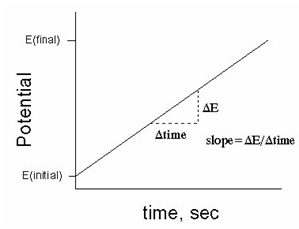Linear Sweep Voltammetry:
The simplest type of voltammetry is called Linear Sweep Voltammetry (LSV). In this technique, the potential of the working electrode is varied linearly as a function of time and the current response is recorded. A scan rates are associatively slow, i.e. less than 5 mV/sec, which allows the movement of fresh analyte to reach the electrode surface, so in which the electrode is always in equilibrium along with the bulk solution. Consider a one electron reduction reaction.
A + e- = B
which obeys Nernst equation.
Eo = 0.00V
Above, E is the potential of the working electrode and E° is the standard reduction potential of A.
If a solution containing only A is taken in a cell and an applied potential of about 200 mV is applied, after that a miniscule amount of current will flow to convert a small amount of A to B so that Nernst equation is obeyed at the electrode surface. An amount of current increases as the potential approached the E°, when E becomes equal to E°, [B] = [A] at the electrode surface or in other words, at E°, half of the total A reaching the electrode is converted to B, so that the current is half way to its limiting current.
Since E is lowered additional, all the A is converted to B, as soon as it reaches the electrode.

Figure: Normal DC polarography